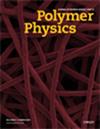Partially fluorinated thermally responsive latices of linear and crosslinked copolymers
3区 工程技术
Q1 Materials Science
Journal of Polymer Science. Part B, Polymer Physics
Pub Date : 1998-09-15
DOI:10.1002/(SICI)1099-0488(19980915)36:12<2141::AID-POLB12>3.0.CO;2-#
引用次数: 18
Abstract
A series of thermally responsive copolymers of N-isopropylacrylamide (NIPAAM) with a fluorinated hydrophobic comonomer, either hexafluoroisopropylmethacrylate (HFIPMA) or 2,2,3,3,4,4-hexafluorobutylmethacrylate (HFBMA) and a hydrophilic comonomer, methacrylic acid (MAA), were synthesized by emulsion polymerization. The chemical structures of the copolymers were studied by the IR technique. Dynamic light scattering (DLS) showed that aqueous latices of the copolymers exhibited swelling–deswelling changes typical to PNIPAAM; the degree of swelling as well as the temperature at which the polymers collapse depended on the chemical structure of the comonomers. Endotherms related to the contraction of the polymers were studied by differential scanning calorimetry (DSC). A combination of DLS and DSC results revealed that the hydrophobic and hydrophilic units in the copolymers strongly affected the swelling behavior, as well as the local environment of the PNIPAAM chains. The comonomer HFIPMA increased the hydrophobicity of NIPAAM, reduced the swelling, and caused coagulation of the copolymer of NIPAAM and HFIPMA at temperatures above the critical temperature. Hydrophobicity of HFIPMA also affected the rheological properties of the latex. The HFBMA comonomer increased the swelling of the latex particles. Methacrylic acid added into the associating copolymers made the copolymers to show polyelectrolyte behavior with an increase of swelling and a decrease of the enthalpy change upon the collapse. © 1998 John Wiley & Sons, Inc. J. Polym. Sci. B Polym. Phys. 36: 2141–2152, 1998线性和交联共聚物的部分氟化热响应晶格
采用乳液聚合的方法合成了n -异丙基丙烯酰胺(NIPAAM)与含氟疏水共聚单体六氟甲基丙烯酸异丙酯(HFIPMA)或2,2,3,3,4,4-六氟甲基丙烯酸丁酯(HFBMA)与亲水性共聚单体甲基丙烯酸(MAA)的热响应共聚物。用红外光谱技术研究了共聚物的化学结构。动态光散射(DLS)表明,共聚物的水溶液呈现出典型的PNIPAAM溶胀-溶胀变化;溶胀的程度和聚合物坍塌的温度取决于共聚单体的化学结构。用差示扫描量热法(DSC)研究了与聚合物收缩有关的吸热过程。DLS和DSC结果表明,共聚物中的疏水和亲水单元强烈影响PNIPAAM链的溶胀行为以及局部环境。共聚物HFIPMA增加了NIPAAM的疏水性,减少了NIPAAM的溶胀,并在高于临界温度时引起NIPAAM与HFIPMA共聚物的混凝。HFIPMA的疏水性也影响了胶乳的流变性能。HFBMA共聚物增加了乳胶颗粒的溶胀性。在缔合共聚物中加入甲基丙烯酸使共聚物表现出聚电解质行为,溶胀增大,崩塌时焓变减小。©1998 John Wiley & Sons, Incj .变异较大。科学。B变异较大。物理学报,36 (6):2141-2152,1998
本文章由计算机程序翻译,如有差异,请以英文原文为准。
求助全文
约1分钟内获得全文
求助全文
来源期刊
CiteScore
5.90
自引率
0.00%
发文量
0
审稿时长
2.1 months
期刊介绍:
Since its launch in 1946 by P. M. Doty, H. Mark, and C.C. Price, the Journal of Polymer Science has provided a continuous forum for the dissemination of thoroughly peer-reviewed, fundamental, international research into the preparation and properties of macromolecules.
From January 2020, the Journal of Polymer Science, Part A: Polymer Chemistry and Journal of Polymer Science, Part B: Polymer Physics will be published as one journal, the Journal of Polymer Science. The merged journal will reflect the nature of today''s polymer science research, with physics and chemistry of polymer systems at the heart of the scope.
You can continue looking forward to an exciting mix of comprehensive reviews, visionary insights, high-impact communications, and full papers that represent the rapid multidisciplinary developments in polymer science.
Our editorial team consists of a mix of well-known academic editors and full-time professional editors who ensure fast, professional peer review of your contribution. After publication, our team will work to ensure that your paper receives the recognition it deserves by your peers and the broader scientific community.

 求助内容:
求助内容: 应助结果提醒方式:
应助结果提醒方式:


